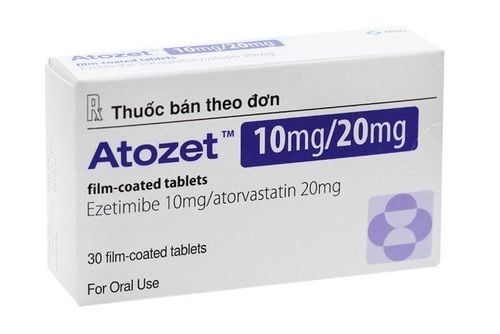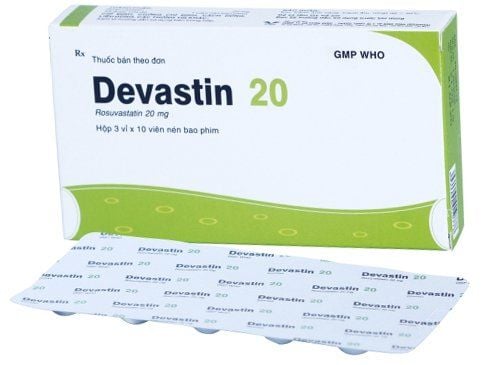This is an automatically translated article.
Oceprava is used to treat primary hypercholesterolemia. The active ingredient in the drug is Pravastatin sodium. To ensure safety and maximize the effectiveness of treatment, patients need to take Oceprava exactly as prescribed by their doctor/pharmacist.1. What is Oceprava?
Oceprava belongs to the group of cardiovascular drugs, made in the form of hard capsules packed in boxes of 10 blisters x 10 tablets. Oceprava medicine has the main ingredient pravastatin sodium 10mg. Oceprava is recommended by pharmacists/physicians and used as an adjunct to dietary therapy in response to a very effective diet.
2. Indications for taking Oceprava
Oceprava is used in the following cases:
Adjunct to diet therapy when diet and exercise combine to lose weight but is not effective in patients with primary hypercholesterolemia type IIa and IIb. Primary prevention: Oceprava is used as an adjunct to dietary therapy to reduce the risk of cardiovascular death in patients with moderate or severe hypercholesterolemia without clinically apparent symptoms and at high risk for cardiovascular disease. heart disease for the first time. Secondary prevention: Oceprava is used as an adjunct to correct risk factors in patients with a history of myocardial infarction or unstable angina with normal or elevated cholesterol to reduce the risk of death. due to cardiovascular disease. Post-transplant: Oceprava helps reduce hyperlipidemia in patients taking immunosuppressive drugs after organ transplantation.
3. Dosage, how to use Oceprava
How to take the drug:
Oceprava is used for oral administration. Before starting treatment with Pravastatin sodium, it is necessary to rule out secondary causes of hyperlipidemia, the patient should follow a standard, low-cholesterol diet and should be maintained during treatment with Oceprava. The dose of Pravastatin sodium should be adjusted according to individual needs and response by increasing the dose at intervals of not less than 4 weeks, until the desired LDL cholesterol concentration is reached or when the maximum dose of Pravastatin sodium is reached. Pravastatin sodium is taken orally once a day, preferably in the evening. Oceprava can be taken with meals or on an empty stomach. Dose of Oceprava as directed by your doctor or refer to the following dosage:
Hypercholesterolemia: 10-40mg Pravastatin sodium/time/day. Response to treatment with pravastatin sodium can be seen within 1 week and is usually maximal after 4 weeks. It is necessary to periodically check lipid levels and adjust the dose. The maximum dose of Pravastatin sodium is 40 mg/day. Prevention of cardiovascular disease: 40mg Pravastatin sodium/day. After organ transplantation: Initial dose of 20 mg pravastatin sodium/day in patients receiving immunosuppressive drugs. Depending on the response of the lipid profile, the dose may be increased to 40 mg pravastatin sodium/day under close medical supervision. Children and adolescents (8-18 years of age) with heterozygous familial hypercholesterolaemia: 8-13 years of age: 10 to 20 mg of Pravastatin sodium once daily and 14 to 18 years of age 10 to 40 mg of Pravastatin sodium. /times/day. Elderly: No dose adjustment is necessary unless there are risk factors for serious disease. Impaired hepatic or renal function: An initial dose of 10 mg pravastatin sodium/day is recommended for patients with moderate to severe renal impairment or severe hepatic impairment. Adjust the dose of Pravastatin sodium according to the response of the lipid index and under the supervision of the physician. Combination therapy:
Co-administration with a bile acid-binding resin (colestyramine, colestipol) will increase the lipid-lowering effect on total cholesterol and LDL - cholesterol. Pravastatin sodium should be taken 1 hour before or at least 4 hours after taking these drugs. For patients receiving ciclosporin with or without other immunosuppressive agents, treatment should be initiated with pravastatin sodium 20 mg once daily and dose titration to 40 mg pravastatin sodium should be performed with caution. . Combination with protease inhibitors: There is no dose restriction when combined with the following HIV and HCV protease inhibitors: Atazanavir, Atazanavir + Ritonavir, Darunavir + Ritonavir and Lopinavir + Ritonavir.
4. What to do in case of an overdose of Oceprava?
There have been reports of some overdoses of Pravastatin. However, patients with no special symptoms can recover and leave no sequelae. If an overdose of Oceprava occurs, the patient should treat symptomatically and provide support when necessary.
5. Contraindications to taking Oceprava
Oceprava drug should not be used in the following cases:
Patients with hypersensitivity or history of allergy to Pravastatin sodium or any other active ingredients in the drug. Active liver disease or persistent elevation of serum transaminases to more than 3 times normal levels for unknown reasons.
6. Oceprava . drug interactions
The following are some possible drug interactions when taken with Oceprava:
The combination of Pravastatin and Fibrates such as Gemfibrozil, Fenofibrate may increase myotoxicity. If co-administration is necessary, clinical caution should be exercised and creatinine kinase monitoring in patients is required. Colestyramine or Colestipol in combination with pravastatin will reduce the bioavailability of pravastatin by approximately 40-50% when co-administered. Patients should take Oceprava 1 hour before or 4 hours after taking Colestyramine or 1 hour before taking Colestypol. Co-administration of Pravastatin with Cyclosporin can result in a 4-fold increase in the amount of Pravastatin in the body. It is necessary to control clinical, biochemical indicators of patients when used in combination with each other. Warfarin and other anticoagulants in combination with pravastatin do not alter the bioavailability of pravastatin and the anticoagulant effect of warfarin. Cytocrom P450-metabolized drugs co-administered with pravastatin are less likely to increase plasma concentrations because pravastatin is not metabolized to cytochrome P450. In particular, Pravastatin does not interact with some drugs that are activated or inhibited by CYP3A4 such as: Itraconazole, Diltiazem, Verapamil, Ketoconazole, protease inhibitors, grapefruit juice, CYP2C9 inhibitors such as fluconazole. The antibiotics Erythromycin and Clarithromycin co-administered with pravastatin increased the AUC and Cmax of pravastatin. Colchicine in combination with pravastatin increases the risk of myopathy/rhabdomyolysis. Niacin in combination with pravastatin increases the risk of effects on skeletal muscle. In this case, a reduction in the dose of Pravastatin should be considered. Concomitant use of Pravastatin with HIV and hepatitis C virus (HCV) drugs may increase the risk of muscle damage, rhabdomyolysis, kidney failure, renal failure, and death.
7. Side effects when taking Oceprava
Oceprava is well tolerated, discontinuation rarely occurs. However, patients may experience some unwanted side effects during taking Oceprava such as:
Uncommon:
Central nervous system disorders: Headache, dizziness, sleep disturbances, insomnia . Visual disturbances: Visual disturbances such as blurred vision, double vision. Digestive disorders: Indigestion, abdominal pain, constipation, diarrhea, heartburn, nausea, vomiting, flatulence. Skin and subcutaneous tissue: Skin itching, rash, urticaria, hair loss. Kidneys and urinary tract: Urinary abnormalities such as frequent urination at night, difficulty urinating. Sexual dysfunction. Musculoskeletal: Muscle spasticity, muscle weakness, myalgia, arthralgia, increased plasma creatine kinase (CK) levels. Hepatobiliary: Increased serum transaminases. Very rare :
Neurological: Paresthesia, peripheral polyneuritis. Immune system: Hypersensitivity reactions such as anaphylaxis, angioedema, lupus-like syndrome. Gastrointestinal: Pancreatitis. Liver: Hepatitis, jaundice, hepatocellular necrosis. Musculoskeletal system: Paroxysmal myoglobinuria leads to secondary acute renal failure, polymyositis, myositis.
8. Precautions when using Oceprava
Liver enzyme tests should be performed before starting treatment with Oceprava and in cases where clinical indications require it. It is necessary to measure creatine kinase (CK) before starting treatment in patients with: Hypothyroidism; impaired kidney function ; personal or family history of hereditary muscle disorders, myotoxicity with fibrates or statins, liver disease, heavy drinking or alcoholism; People > 70 years of age with factors for rhabdomyolysis, the possibility of drug interactions should carefully weigh the benefits and risks of using drugs, need to monitor patients clinically when treated with statins. If creatine kinase measurement is >5 times normal, Oceprava therapy should not be initiated and creatine kinase measurement should be repeated after 5-7 days. During statin treatment, patients should report when there are symptoms such as muscle stiffness/pain/weakness... When these symptoms are present, the patient should have a CK test for appropriate interventions. Oceprava should be discontinued if muscle symptoms are severe, causing daily discomfort, even if the CK elevation remains at ≤ 5 times the upper limit of normal (ULN). If symptoms resolve and CK levels return to normal, reintroduction statin therapy may be considered at the lowest dose and closely monitored. If hereditary myopathy is suspected in these patients, treatment with pravastatin should not be resumed. In the drug Oceprava contains lactose, people with a history of lactase deficiency, galactose intolerance or glucose-galactose malabsorption should not take the drug. Oceprava is contraindicated during pregnancy. Use only when the patient is absolutely not pregnant, if the patient plans to become pregnant or is pregnant, the patient should inform the treating doctor. There are data indicating that small amounts of pravastatin are excreted in human milk. Therefore, Oceprava is contraindicated during lactation. Oceprava has little or no influence on the ability to drive and use machines. However, the drug has a side effect of dizziness, so it should be used with caution. In summary, Oceprava is used to treat primary hypercholesterolemia. To ensure safety for your health and maximize the effectiveness of your treatment, you need to take Oceprava exactly as directed by your doctor.
Please dial HOTLINE for more information or register for an appointment HERE. Download MyVinmec app to make appointments faster and to manage your bookings easily.













